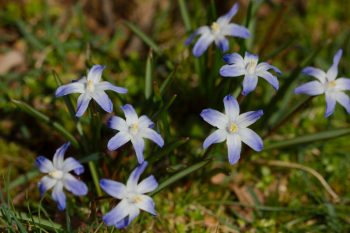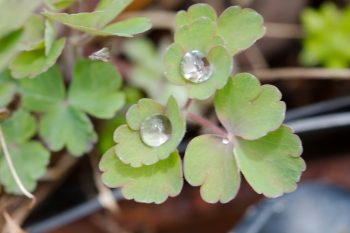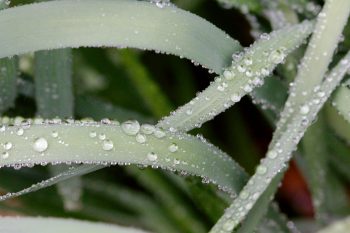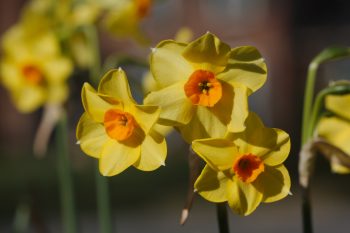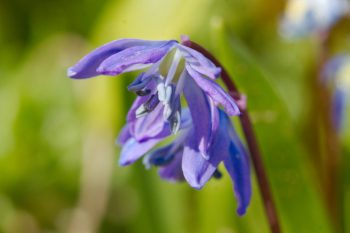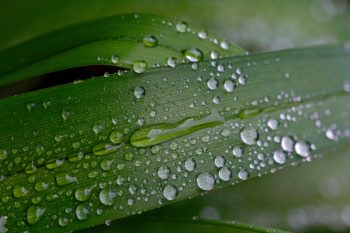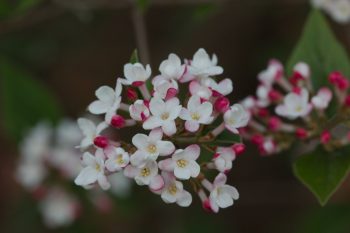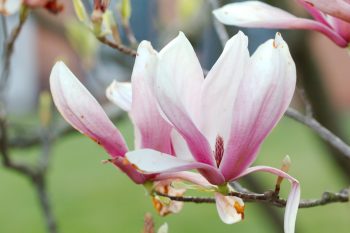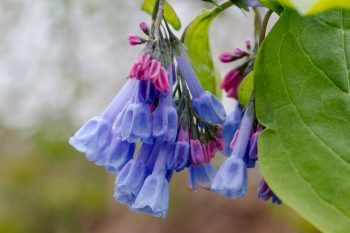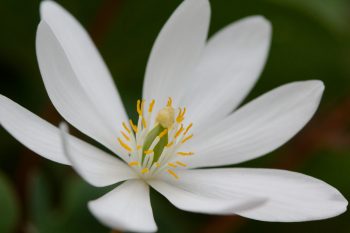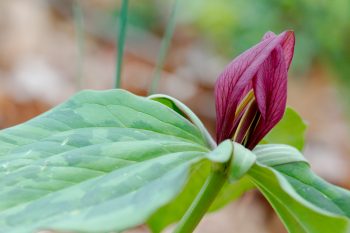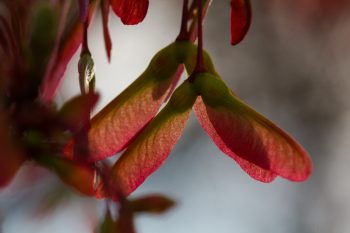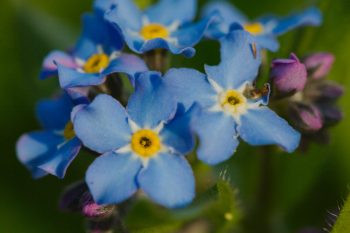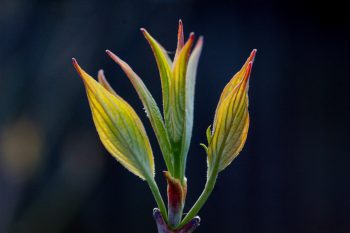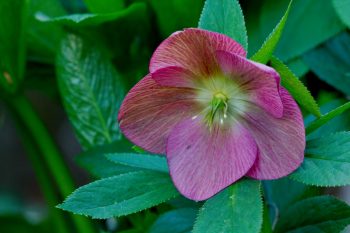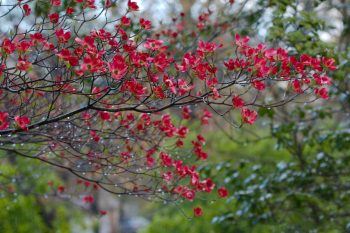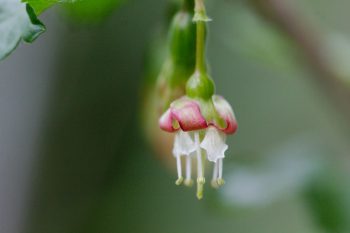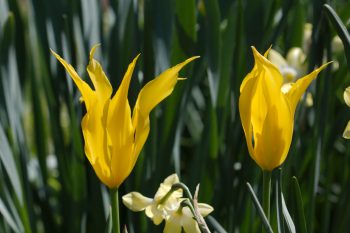I think this is my absolute favorite of the spring ephemerals. It’s called glory of the snow in honor of it’s generally very early blooming time, sometimes when there is still snow on the ground. The genus Chionodoxa comes from the Greek words chion meaning snow and doxa meaning glory. I think it’s the color that I like best about it, along with its dainty habit and it’s remarkably easy care. It is hardy as far north as USDA zone 3. In a few short weeks it will be done and gone for the year, sleeping away both the heat of summer and the cold of next winter.
Tagged With: Spring
Chionodoxa forbesii
Columbine Leaves
It’s been really nice weather lately, which is great. Since we’re staying around the house, it’s been good to get outdoors, even if only into the yard. We say hello to all the neighborhood walkers, of which there are quite a lot. Today was a bit dreary by comparison so we spent most of the day indoors. I did get out a bit and took a few pictures of things in front of the house, including this columbine leaf with two large water droplets.
Daffodil Leaves In The Rain
It rained again today and I spent most of the day indoors, working. We’re into our second week of the great coronavirus hunker of 2020 and it’s been a mixed bag. On the one hand, when the weather has been nice, which has been most days, it’s been great to get out into the yard. That’s nicer than just going out into the parking lot at work. But when it’s cool and dreary, and I’ve stayed indoors, it’s gotten a bit old, sitting at my computer. It’s nice to be able to do that in an armchair with the computer on my lap, but it’s still work and I much prefer to be able to go outside.
Daffodil ‘Falconet’
One nice thing about being home as we all are is that it means I can get out into the yard during the day. That’s offset by the fact that we can’t go a lot of other places, of course, but we are fortunate to have a pretty nice yard. There’s a huge amount that needs to be done but right now, with the daffodils blooming, it’s quite nice. This little daffodil, one of the Tazetta types, has multiple fragrant flowers on each stem. They were planted in 2014 and are on the edge of the bed that used to surround the spruce tree, which is gone, so they will get a lot more sun now.
Scilla siberica
Blooming shortly after the beautiful, blue Chionodoxa forbesii (glory of the snow), the Scilla siberica (Siberian squill) are starting to come out. They are a darker blue with down-turned flowers but quite similar. In fact, “some experts have merged Chionodoxa into the genus Scilla under the belief that the differences are not significant enough to warrant separate genus status.” (Missouri Botanical Garden, Plant Finder). I don’t really care one way or the other and just enjoy them both as spring ephemerals. I look forward to their bloom every year and don’t think I could have too many of either.
Rainy Day
After a week of mostly beautiful weather, today was grey and rainy. It was nice to be home from the office, meaning I didn’t go into the basement much, but mostly I just read and dozed and did this and that all day. I did go out in the evening to take a few pictures but there wasn’t much to see and I didn’t feel like walking around in the wet to find something more interesting. This is the view to the southeast from the front of our house, looking past a few large oaks to more trees at the end of the block. The maples are mostly in bloom, which accounts for the rusty red shades. The oaks will be out soon, adding a bit of yellow and then everything will be dusted heavily with pollen.
Daffodil ‘Actaea’
This is a daffodil called ‘Actaea’, which is in the poeticus division (division 9), which are distinguished by their large white petals and small, dainty cups in contrasting colors. I think they are fairly posh, compared to their more boisterous cousins but they are similar in their hardiness. They are a bit slower to produce large clumps, though, so if you want a lot of them in a hurry, you’ll want to plant more of them up front. The stems on these are a little less rigid than the others, as well, and they have a tendency to droop even more when it rains but in the sun, they are hard to beat.
Water Droplets
We had another rainy day today, to end March. It’s been so warm and sunny lately that it was a bit of a shock to stay indoors all day. I did get outside long enough to take a handful of pictures, but really not much more than that. These are daylily (Hemerocallis) leaves with rain on them, and the rain continued to fall while I was taking it. I probably should have spent the time to get a tripod and really focus carefully, but I just needed to get a picture. Maybe next time. Sorry.
Viburnum carlesii
One thing Cathy and I are thankful for is walks in our neighborhood. It’s a relatively quiet neighborhood, especially now, as traffic in the area is considerably lighter than normal. Foot traffic has always been high with a lot of dog walkers and people out for a stroll but that’s increased significantly during the covidian interval. This shrub, Viburnum carlesii, is scattered through the area and right now, you can often smell it before you see it. The fragrance it strong, spicy, and sweet with a hint to me of vanilla. This and Viburnum × burkwoodii, which is cross with V. utile, are among the best viburnums for fragrance (and it’s possible that the one in this photo is the hybrid rather than the species). In fact, Cathy has requested that I plant one in our yard when we’re able to browse the garden centers once more.
Magnolia × soulangeana
Most of the saucer magnolias (Magnolia × soulangeana) have finished their bloom but there are a few in the neighborhood that are still at their peak. This has been a good year for the magnolias, coming a little early and with no late frost to damage them. The saucer magnolia is a hybrid of M. denudata x M. liliiflora. The first of those, the yulan magnolia, has pure while flowers, which seems like it would be very nice, as well. The second, commonly called the lily magnolia, is a bit more hardy and provides the hybrid with its color. Many of the named varieties of saucer magnolia come from a breeding program at the U. S. National Arboretum. The hybrid epithet comes from Chevalier Etienne Soulange-Bodin (1774–1846), a “disgruntled cavalry officer.”
Mertensia virginica (Virginia Bluebells)
Like most folks, we’re mostly confined to our house and to walks in the neighborhood. We figured that we could go for a drive so yesterday we went out and about. One place we went was the Montgomery County Agricultural History Farm Park on Muncaster Road. I didn’t take my camera with me, which is pretty unusual, so we went back there today with my camera this time. There were a few others there but everyone kept their distance from one another.
They have a small, woodland garden that is particularly nice right now, with mostly early spring blooms. These Virginia bluebells (Mertensia virginica) are just starting to open and are so lovely.
Sanguinaria canadensis (Bloodroot)
Another photo from our trip to the Montgomery County Agricultural History Farm Park on Muncaster Road. Bloodroot (Sanguinaria canadensis) has very pretty, pure white flowers that don’t last very long. I love them as a true sign of spring. There are some places where you see this native plant in the woods one day as you drive by and then it’s gone the next. The plant is still there, obviously, but not so obvious without it’s bright blooms. The leaves are quite interesting, being deeply-scalloped. The leaves continue growing after the blooms are gone, and are present until mid to late summer when the plant goes dormant.
Trillium
The third and final photo I’ll post from our visit to the Montgomery County Agricultural History Farm Park today. This is trillium and someone more in the know than I am could probably tell you which one. I’ll guess Trillium cuneatum, “the largest and most vigorous of the sessile trilliums that are native to the eastern U. S.” but I stress, that’s just a guess without much research behind it. Whichever it is, it’s a pretty little plant that should be in any woodland garden in our region. They don’t transplant well but it seems to me they would be worth the effort.
Photo 175,000 — Maple Samaras
Cathy and I went for a walk in the neighborhood after work this evening. I had hoped to have a photo of a pile of rocks dressed up as a nurse. There is a house a few blocks from us with a stack of rocks, between 4½ and 5 feet tall. Occasionally they “dress” them in something for the occasion, such as with a Santa suit at Christmas. Yesterday, Cathy saw them in a nurses outfit, presumably in honor of health care workers during the covidian interval. Unfortunately, they were back to their bare selves this evening. So, instead, I give you photo number 175,000 from my camera, some maple samaaras, or winged seed capsules on a tree down the street from us.
Technically, this is only photo number 174,983 because the photos are numbered from 1 through 9,999 and then it starts over at 1, meaning there is no photo numbered 10,000, 20,000, etc., so the 175,000th photo will have been taken tomorrow (but I probably won’t post that one).
Myosotis sylvatica (Woodland Forget-me-not)
The woodland forget-me-not (Myosotis sylvatica) is blooming in our back yard. Cathy planted these and they have spread to various places, mostly in the lawn, and they are very pretty little things. Similar to the flowers of the Virginia bluebell (Mertensia virginica) he buds are pinkish purple and the flowers change to blue as they open and mature. Also, the little white “eye ring” around the center change from white to yellow. They are delicate little flowers and although they are not a native species, they are lovely and don’t go to crazy in our yard, so I don’t mind.
Dogwood Leaves
The afternoon sun was lighting up the newly opened leaf buds on a small flowering dogwood (Cornus florida) in our back yard. I got my camera and went to take pictures but between the wind moving the stems around and the sun going behind clouds, it kept changing. I think this is my favorite of them, although the light is a bit less strong than it was in others. Our eyes are amazing in terms of their dynamic range and cameras have a much harder time with extremes of light at dark. So, in the one that’s brighter, parts are a bit washed out, although in Real Life™ it was gorgeous. This one, where the light was a bit more subdued, has the right feel. Just imagine it super-bright.
Lenten Rose
With Easter in two days, as Lent comes to an end, the Lenten roses are finishing up a very spectacular year. They are pretty reliable, once established, but this year has been particularly good for them in our neck of the woods. This one is either ‘Red Racer’ or ‘Rose Quartz’ and I’d have to check my notes to know which. They were both planted in the fall of 2014 and are near each other but I don’t remember which is which. Regardless, it’s got a really nice color, even as the flowers age.
Pink Flowering Dogwood
We had rain overnight and it continued into the day, raining quite hard off and on. In the early afternoon I could hear thunder from my basement office and I lost the remote connection to one of my office computers, although the other stayed connected. I went out front, under the porch, and took a few pictures of the rain. In the few minutes that I was outside, the rain stopped. This photo was taken then, of a pink flowering dogwood (Cornus florida) growing and blooming at the front of our house. I loved the way the drops of water were glistening on the branches. A few minutes later I went out back and half the sky—to the south and west—was blue, while the other half—to the north and east—was still an ominous grey. The thunder faded into the distance as the storm moved on.
Gooseberry Flower
The plant this gooseberry flower is on was one that Albert had growing in his yard. Brady left me dig it up before she moved out of that house and it’s done very well against our back fence. Dorothy made little tarts with gooseberries from it last year and it looks to have a pretty good crop again this year, if the number of flowers tells us anything. The flowers are generally considered insignificant, at least from an ornamental standpoint. They are quite small and not particularly showy except from very close but they are actually pretty little things. The gooseberry (Ribes uva-crispa) is native to Europe, N. Africa, and the Caucasus and is, as you’d guess, primarily grown for it’s wonderfully tart fruit. The leaves of gooseberries contain hydrogen cyanide, a toxin that, in sufficient quantities, is pretty bad for you.
Tulipa acuminata
Where there used to be a large oak tree in our front yard (technically in the road right-of-way) there is now a small garden bed. Around the tree was Pachysandra terminalis and that’s still there. Where the tree was Cathy plants annuals and there are some tiger lilies there now, as well, which seem to enjoy the spot. Around the permimeter are daffodils of various types, all different shades of yellow. They look bright yellow until these fireflame tulips (Tulipa acuminata) start to bloom with their really intense yellow flowers.

